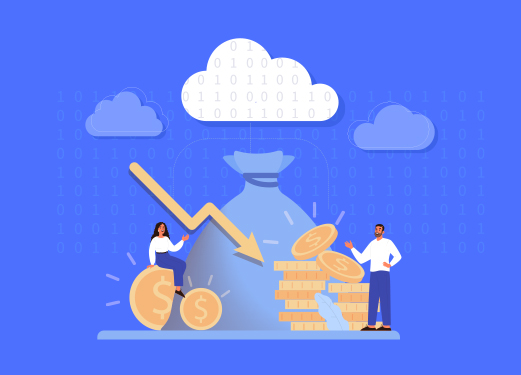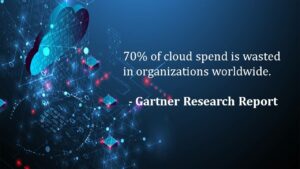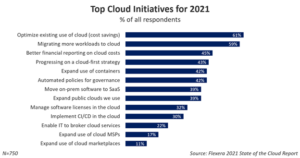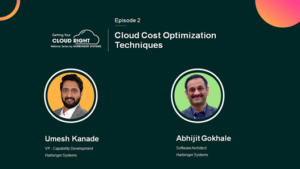
Organizations often miss setting up a cloud cost optimization plan when starting their cloud adoption journey. This frequently leads to cloud sprawl. If you’re wondering what cloud sprawl is, it is the uncontrolled, unnecessary increase in the number of an organization’s cloud instances, services, or providers, resulting in excessive cloud expenditures.
The cloud has immense potential. But that doesn’t discount the need to optimize cloud spending to control costs and reduce waste. When organizations transition to the cloud, on-demand consumption can exhaust promised cost savings and push consumption beyond the planned budget.
Irrespective of where an organization is in its cloud adoption journey, determining where and how cloud costs rise is a significant challenge. The reality is that cloud customers pay for what they order and mostly don’t use it.
Amazon Web Services (AWS) and Microsoft Azure charge cloud customers for the total number of resources they purchase, even if some resources go unutilized. Duplicate and dormant resources add thousands or even millions of dollars to wasted expenditures every year.
This is where cloud cost optimization comes to the rescue.

Harbinger’s Getting Your Cloud Right webinar series promises to cover all essential aspects of the cloud, whether you are transitioning to the cloud, simply migrating to a hybrid environment, or optimizing your production.
This blog, the second in our series on the cloud, takes a closer look at cloud cost optimization. It also focuses on cloud cost management benefits and strategies to help organizations optimize and manage their cloud spending.
What is cloud cost optimization?
Cloud optimization is the process of appropriately choosing and allocating the right resources to a workload or application. When it comes to cloud cost optimization, it involves rightsizing the computing service for scale, eliminating waste, securing more significant discounts, and targeting mismanaged resources.
For several years, optimizing cloud costs has been a primary focus of most organizations. The graph below shows that ‘optimizing the existing use of the cloud (cost savings)’ was the top initiative for 2021. This initiative was followed by ‘migrating more workloads to the cloud’ and ‘better financial reporting on cloud costs.’

Cloud cost management becomes imperative as the cloud infrastructure matures and the complexity of its structure increases. Complexities such as multi-cloud deployment can make costs more opaque and harder to track. When it becomes difficult to monitor and manage cloud usage properly, organizations risk seeing cloud costs spiral out of control.
Cloud computing costs are determined by various factors, including virtual machine instances, network traffic, software licenses, training and support, web services, storage, and memory. The upfront cost may not include these variables, thus contributing to a surge in the total cloud cost.
Today, organizations need a cloud cost model that is tailored to their specific business requirements and provides results within the specified time and budget.
Organizations must identify what they are doing right and where they can improve to maximize the value of their cloud migration and spending. A good cloud optimization strategy, thus, is the need of the hour.
7 cost optimization strategies to prevent rising cloud bills
Every organization develops different cloud cost optimization strategies based on the nature of its business, organization size, and other aspects. However, regardless of the type of business or organization size, the proven strategies and best practices discussed below will enable you to minimize cloud costs and maximize cloud benefits.
1. Identify unused resources
Identifying underutilized resources is one of the simplest methods to optimize cloud costs effectively. Imagine setting up a temporary server for a specific task and forgetting to switch it off later or failing to remove storage associated with terminated instances. These are common real-life examples of irregularities that contribute to rising cloud costs within an organization.
Identifying and deleting such resources are ideal for cloud cost optimization and can benefit any organization. Harbinger’s cloud engineering services make it easy to quickly identify underutilized infrastructure and provide recommendations for downgrading or terminating unused assets.
2. Merge idle resources
A resource that’s idle or dormant but being charged by the service provider is a huge waste, and it must be addressed to optimize costs. Despite utilizing only 10% of the CPU capacity for current operations, organizations are being charged for 100%. Organizations must focus on all such resources within their system and consolidate them for cloud cost savings.
Organizations can leverage cloud features like auto-scaling, on-demand capabilities, and load balancing to increase computing capacity and save unnecessary expenditures. This strategy is very helpful, especially during a busy season or in the event of a traffic spike.
3. Rightsize the resources
Rightsizing refers to reviewing computer services or cloud resources to discover the most efficient size for them as per the organization’s operational requirement. Resource rightsizing involves the process of upgrading, downgrading, or terminating cloud resources based on their utilization. This is determined by the type and size of the workload handled by the cloud resource or virtual machine in consideration.
The right rightsizing tool can help optimize the size of the server and other elements such as database, memory, storage capacity, and graphics. Effective rightsizing prevents over-provisioning and idle instances, especially in pay-as-you-go public cloud environments like AWS, Azure, and Google Cloud Platform (GCP) with in-built autoscaling capabilities.
4. Consider reserved instances
Organizations can take advantage of large price discounts on cloud services by reserving instances. These are substantial discounts offered in exchange for time commitment and upfront payment. According to AWS, the EC2 Reserved Instances offer up to 75% discounts compared to On-Demand pricing. Organizations should base their future demand on a thorough analysis of past usage patterns to extract the most value from reserved instances.
5. Leverage heatmaps
Heatmaps show the times when cloud services are most heavily used and when they are underutilized. If an organization wishes to establish start and stop times, insights offered by a heatmap can be a valuable asset to save money. A heatmap can indicate whether weekend shutdowns of development servers are safe.
Organizations can also automate the start and stop schedules for different instances. This means they can eliminate the elements of error associated with performing these tasks manually and optimize costs to the maximum.
6. Invest in spot instances
Spot instances are specialized AWS instances sold in an auction to the highest bidder by cloud service providers and are ready for use immediately after purchase. Spot instances are up to 90% cheaper than On-Demand instances, significantly reducing the EC2 costs.
A spot price is an hourly rate associated with a spot instance. AWS determines the spot price for each instance type in each availability zone based on spot instances’ evolving supply and demand. Spot instances are temporarily available and are best suited to computing jobs that can be terminated quickly. Spot instances are appropriate for stateless, fault-tolerant, or ad-hoc applications such as data analysis, batch jobs, background processing, and optional tasks.
7. Streamline cost with tools
Cost optimization tools within management platforms can increase visibility into their cloud costs and utilization. While each cloud platform has unique features, every cost management tool helps an organization by:
- Providing insight into cloud utilization
- Keeping monthly bills in check
- Reducing management overhead
- Precisely forecasting expenses and allocating costs
Employing free, native AWS cost analysis tools such as AWS Cost Explorer, AWS Cost Anomaly Detection, AWS Budgets, and Amazon Cloud Watch may be a good starting point for small companies with relatively straightforward cloud bills. GCP Billing, Azure Pricing Calculator, and Apptio Cloudability are other tools that help visualize, manage, and reduce cloud costs, both in silos and collaboratively.
Takeaway
Cloud cost optimization helps users manage cloud costs while achieving optimal cloud performance with high visibility, productivity, efficiency, and innovation. And in a time when services have been disrupted and resources are limited, having more control over spending is vastly beneficial.
Harbinger just released the second episode of its Getting Your Cloud Right webinar series. In this episode cloud experts Umesh Kanade and Abhijit Gokhale shared valuable insights on the best practices for cloud applications cost management and optimization. They also shed light on improving the visibility of cloud applications’ performance with effective cloud financial management strategies.







